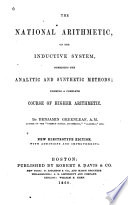 | Benjamin Greenleaf - 1857 - 452 σελίδες
...divided by the number of common differences, 21, gives 2 as the common difference required. RULE. — Divide the difference of the extremes by the number of terms less one, and the quotient will be the common difference. EXAMPLES. 2. A certain school consists of 19 teachers... | |
 | Benjamin Greenleaf - 1857 - 336 σελίδες
...be the common difference. Thus, 27 -S- 9 = 3, the common difference. Hence the following RULE. — Divide the difference of the extremes by the number of terms less one, and the quotient is the common difference. EXAMPLES FOR PRACTICE. 1. The extremes of a series... | |
 | Horatio Nelson Robinson - 1859 - 348 σελίδες
...thus, by taking away 2 in the fifth term, 2-J-3 + 3 + 3 + 3, we have 3 taken 4 times. Hence, RULE. Divide the difference of the extremes by the number of terms less one. EXAMPLES. 1. The first term is 2, the last term is 17, and the number of terms is 6 ; what is... | |
 | Silas Lawrence Loomis - 1859 - 324 σελίδες
...PROB. CLIII. — GIVEN, THE EXTREMES AND NUMBER OF TERMS, TO FIND THE COMMON DIFFERENCE AND MEANS. RULE Divide the difference of the extremes by the number of terms, less one, for the common difference. Then construct the series by P/ob. CL. PROB. CLIV. — GIVEN, THE EXTREMES... | |
 | Horatio Nelson Robinson - 1860 - 444 σελίδες
...the common difference multiplied by the number of terms less 1, (706), we have the following RULE. Divide the difference of the extremes by the number of terms less 1. EXAMPLES FOR PRACTICE. 1. If the extremes of an arithmetical series are 3 and 15, and the number of... | |
 | Benjamin Greenleaf - 1860 - 456 σελίδες
...divided by the number of common differences, 21, gives 2 as the common difference required. RULE. — Divide the difference of the extremes by the number of terms less one, and the quotient will be the common difference. EXAMPLES. 2. A certain school consists of 19 teachers... | |
 | Roswell Chamberlain Smith - 1861 - 298 σελίδες
...— 3 = 2o ; then, 25 -s- 5 = 5 years, the common difference. A. 5 years. Hence, To Find the Common Difference; — Divide the difference of the extremes...common difference. 2. If the extremes be 3 and 23, and tho number of terms 11, what is the common difference ? A. 2. 3. A man is to travel from Boston to... | |
 | Daniel Adams - 1861 - 452 σελίδες
...RULE. Divide the whole number added or subtracted, by the number of additions or subtractions, that is, the difference of the extremes by the number of terms less 1, and the quotient is the number added or subtracted at one time, or the common difference. EXAMPLES. 2. If the extremes... | |
 | Emerson Elbridge White - 1861 - 348 σελίδες
...The first term, number of terms, and last term being given to find the common difference. RULE. — Divide the difference of the extremes by the number of terms, less one. (3). The first term, common difference, and last term being given to find the number of terms.... | |
 | James Stewart Eaton - 1862 - 320 σελίδες
...difference, divided by 3 (15 -s- 3 = 5), gives one of these additions, ie the common difference. Hence, RULE. Divide the difference of the extremes by the number of terms less one, and the quotient will be the common difference. Ex. 1. The extremes of an arithmetical series... | |
| |